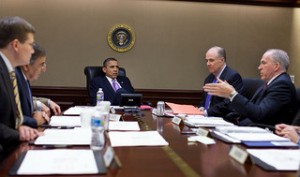The “Torture Works” Story
After Adam Goldman exposed the identity of Jihadi John, ISIL’s executioner, as Mohammed Emwazi, it set off an interesting response in Britain. CagePrisoners — the advocacy organization for detainees — revealed details of how MI5 had tried to recruit Emwazi and, when he refused, had repeatedly harassed him and his family and prevented him from working a job in Kuwait (where he was born).
While that certainly doesn’t excuse beheadings, it does raise questions about how the intelligence services track those it has identified as potential recruits and/or threats.
And seemingly in response to those questions, the former head of MI6 has come forward to say that torture has worked in a ticking time bomb scenario — that of the toner cartridge plot in 2010.
In his first interview since stepping down from Secret Intelligence Service in January, Sir John Sawers told the BBC yesterday that torture “does produce intelligence” and security services “set aside the use of torture… because it is against the values” of British society, not because it doesn’t work in the short term. Sir John defended the security services against accusations they had played a role in the radicalising of British Muslims, including Mohammed Emwazi, who it is claimed is the extremist responsible for the murder of hostages in Syria.
The IoS can reveal details of a dramatic “Jack Bauer real-time operation” to foil an al-Qaeda plot to bring down two airliners in 2010. According to a well-place intelligence source, the discovery of a printer cartridge bomb on a UPS cargo aircraft at East Midlands airport was possible only because two British government officials in Saudi Arabia were in “immediate communication” with a team reportedly using torture to interrogate an al-Qaeda operative as part of “ticking bomb scenario” operation.
The terror plot was to use cartridge bombs to bring down two aircraft over the eastern United States. However, British authorities intercepted the first device at the cargo airport hub after what they described as a “tip-off” from Saudi Arabia. A second device was intercepted aboard a freight plane in Dubai; both aircraft had started their trips in Yemen.
The IoS understands there was a frantic search prompted by “two or three” calls to Saudi Arabia after the tip-off, with security services battling to find the device. French security sources revealed the device was within 17 minutes of detonating when bomb disposal teams disarmed it.
One intelligence source said: “The people in London went back on the phone two or three times to where the interrogation was taking place in Riyadh to find out specifically where the bomb was hidden. There were two Britons there, in immediate communication with where the interrogation was taking place, and as soon as anything happened, they were in touch with the UK. It was all done in real time.”
I find this rather interesting for several reasons.
At the time, multiple sources on the Saudi peninsula revealed that authorities learned of this plot — and therefore learned about the bombs — from an apparent double agent (and former Gitmo detainee), Jabir al-Fayfi, who had left AQAP and alerted the Saudis to the plot. If so, it would mean what was learned from torture (if this account can be trusted) was the precise location of the explosives in planes that boxes that had already been isolated. I’m not certain, but that may mean this “success” prevented nothing more than an explosion in a controlled situation, because it had already been tipped by a double agent who presumably didn’t need to be tortured to share the information he had been sent in to obtain.
That is, the story, as provided, may be overblown.
Or may be referring to torture that happened in a different place and time, as part of an effort to “recruit’ al-Fayfi.
But I’m interested in it for further reasons.
The toner cartridge story significantly resembles the UndieBomb 2.0 plot, which was not only tipped by a double agent, but propagated by it (indeed, I recently raised questions about whether leaks about both were part of the same investigation). But in that case, the double agent came not via Gitmo and Saudi “deradicalization,” but via MI5, via a recruitment effort very like what MI5 used with Emwazi.
Indeed, it is not unreasonable to imagine that Emwazi knew that double agent and/or that CagePrisoners has suspicions about who he is.
I have increasingly wondered whether the treatment of a range of people implicated in Yemeni and/or Somali networks (MI5 accused Emwazi of wanting to travel to the latter) derives from the growing awareness among networks who have intelligence services have tried to recruit who else might have been recruited.
Which might be one reason to tie all this in with “successful torture” — partly a distraction, partly an attempt to defer attention from a network that is growing out of control.

